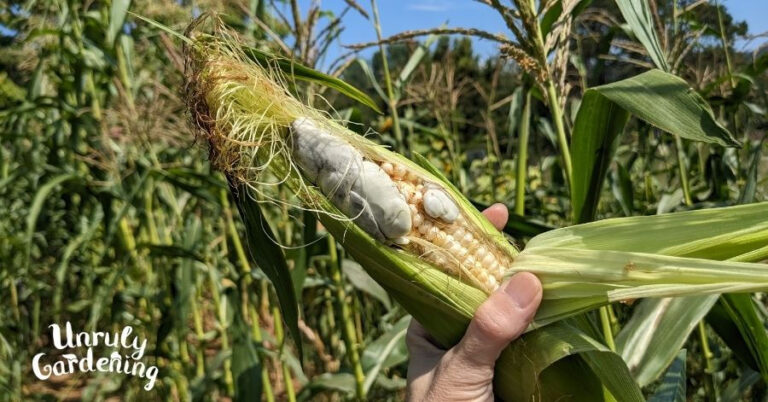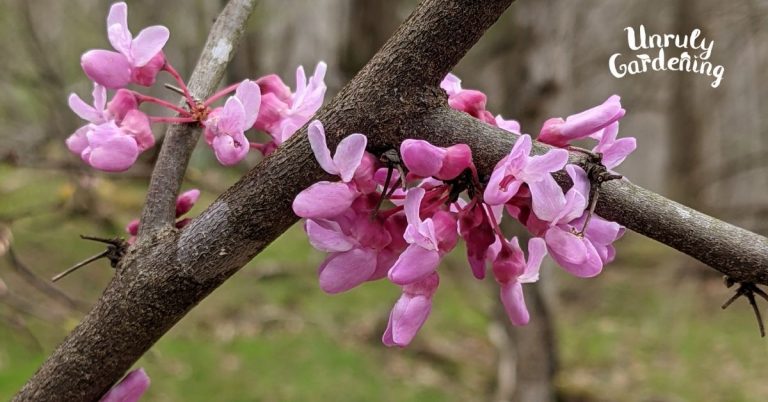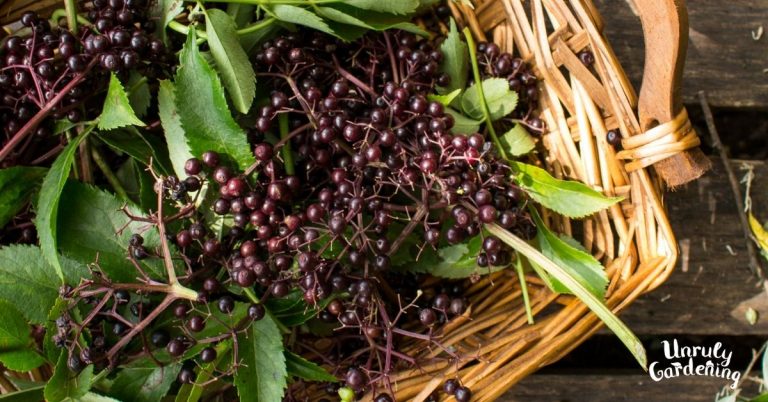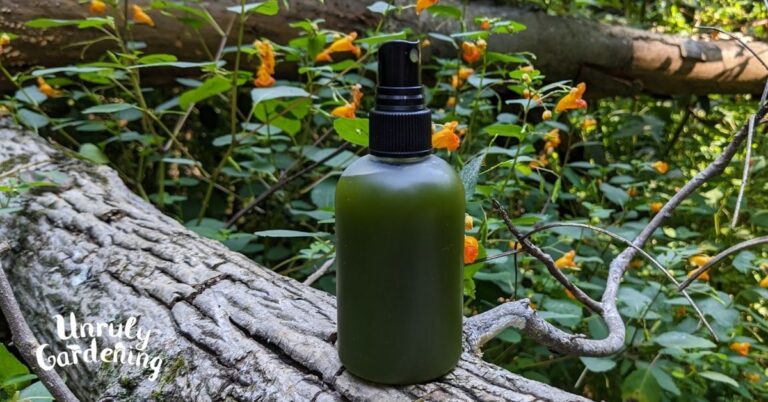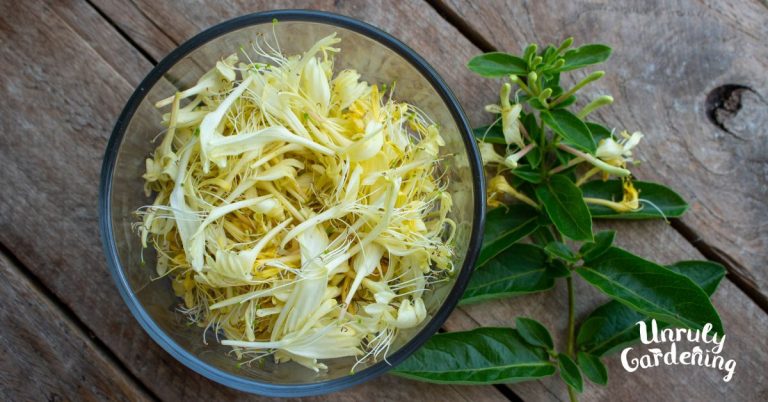Foraging & Using Chickweed
Learn how to identify and use chickweed – a common backyard weed that’s nutritious and delicious, and can also be turned into salves for itchy skin, and more!

Where & When to Look for Chickweed
While common chickweed (Stellaria media) isn’t a native plant, it has naturalized and spread all over North America, and is likely to be found where you live. Check your lawn for cool, moist, or shady spots and you might spot some.
A good time to look for chickweed is early spring since that’s when you’re most likely to spot it blooming. (The small white flowers are a key identifier if you’re new to foraging.) In our area, USDA zone 7a, we find it growing year ’round in the sheltered and shady areas around our creek, but it tends to fade away in the garden and yard during the hottest parts of summer.

Like other wild edibles that are considered weeds, chickweed seems to especially enjoy growing in flower and vegetable gardens – much to the chagrin of some gardeners!
If you need to pull chickweed out of your garden to make room for veggies and such, it’s fine to do. It isn’t in short supply or threatened in any way. (Be sure to save some of that pulled chickweed though for food and other uses listed below!)
ID Tips for Common Chickweed
Chickweed is a small low growing annual that’s native to Europe and that loves cool moist soil. You’re most likely to find this medicinal weed growing as a dense mat of greenery in early spring, or late fall. (In our climate, zone 7a, we can still find patches of it in sheltered spots in winter and summer as well.) Look for patches growing in your garden beds, cold frames, or around the edges of sheds, barns, and fences.
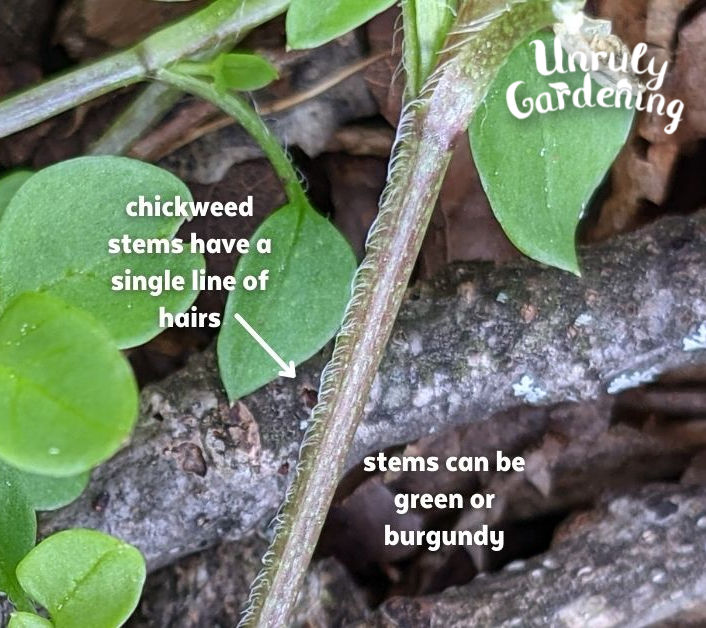
Stem ID Tips
When identifying common chickweed (Stellaria media), first check the stem.
You should see a single line of fine hairs running up the side of the stem. Every time the row of hairs meets a leaf, then the hairs tend to switch to another side of the stem. But instead of being completely covered in hair, common chickweed’s stem has that single line of hairs going on.
If you can’t see it well, try taking a photo of the stem with your phone, then open up the picture and zoom in on the stem area. You should be able to more clearly see this key identifier.
The stem will NOT have a milky sap coming from it. If you break the stem and see that it has a milky or white sap, it’s not chickweed. It’s probably a lookalike called spurge (Euphorbia spp), and should not be used.
Chickweed stems can be shades of green or burgundy.

The Leaves
Chickweed’s leaves are oval to egg shaped and grow opposite from each other along the stem. The lower leaves usually have stalks, but the upper leaves are usually stalkless. Common chickweed leaves are green and mostly hairless, but may have fine hair on the margins of their base.
The sepals (the green parts that enclose and grow around the flowers) are hairy.

The Flowers
Common chickweed’s flowers are small and white. While they look like they have ten petals, they actually have only five petals that are deeply divided. A portion of its Latin name, Stellaria, means ‘star’ – an apt description of the tiny white flowers.
If you’re uncertain about the ID of chickweed, wait and make sure it’s blooming with small white flowers before you pick it. Its main non-edible lookalike, scarlet pimpernel (Anagallis arvensis), has red or reddish-orange flowers.
Chickweed Lookalikes
Two primary lookalikes to be concerned with are scarlet pimpernel and spurge.

Scarlet pimpernel (Anagallis arvensis) has scarlet or red-orange flowers with five petals, and it does not have the single row of hairs on the stem. If you aren’t sure if you have chickweed or not, check the stem and/or wait to collect it until it blooms, so you can verify that the flowers on your plant have white petals.
Some very young spurge, such as radium weed or petty spurge (Euphorbia peplus), may somewhat resemble chickweed if you’re new to foraging. However, spurge has a milky sap if you break the stem open. Chickweed does not have a milky white sap. Don’t use a plant that looks like chickweed if it has a milky sap or red flowers.
There is also a perfectly edible and similar chickweed variety called mouse-ear chickweed (Cerastium fontanum). Main differences are that mouse ear chickweed has completely hairy stems and leaves (making them less palatable to humans), and the 5 petals on their white flowers are less divided. (See “Chickweeds with different genus names” for a great photo comparison of the two.)

Parts of Chickweed to Eat
You can eat or consume the entire upper portion of the plant – this includes the leaves, stem, and flowers.

How to Harvest
Harvesting chickweed couldn’t be simpler. Just grab up a handful and snip it with scissors. You could also pinch off the tops with your fingers. The top 1/4 to 1/3 of the plant is usually most desirable to eat.
Often in the garden, you might find chickweed tangled with another plant. When foraging, just be certain that you’re pulling only from that plant.
The best time to harvest chickweed is when it’s young and tender. Once it goes to seed, or gets leggy or yellowed with age/heat it’s not ideal for use.

How to Dry
Spread freshly gathered chickweed out in a single layer on a drying screen, paper towel, or clean dish towel. Don’t pile up the herbs, or they’ll start to compost on each other. Instead, make sure there’s airflow and room. Allow to air dry for several days.
Alternatively, you can use a dehydrator set to 95 degrees F for several hours.
There’s a lot of water content in chickweed, so you’ll find that it shrinks up quite a bit when dried. That’s perfectly normal!
Once completely dried, store the dry herb in a brown paper bag or a glass jar out of direct sunlight and heat. The dried herb is fine to use as long as it is a nice green color with a good scent. If it starts to turn brown or badly faded, or smell musty, then it’s time to compost it!

Chickweed Uses
Both a nutritious food and an herbal remedy, common chickweed has many uses! It’s a “traditional Chinese medicine that has been used for over 200 years, mainly for the treatment of dermatitis and other skin diseases. It has also been used as an anti-viral agent.” (study source)
Chickweed as Free Nutritious Food
Loaded with minerals, vitamins, and nutrients, chickweed is an edible and beneficial tonic food. It’s said to help improve energy levels, and is a good ‘spring cleaning food’ to help detoxify sluggish systems. Esteemed herbalist, Richo Cech, mentions in his book, Making Plant Medicine, that the saponins in chickweed help “scrub toxins from the bloodstream and gastrointestinal system.”
According to a 2015 study published in Integrative Medicine Research, the leaves of Stellaria media contain vitamin C, carotene, and mucilage and are rich in potassium and silicon.
Raw chickweed can be nibbled on right in the garden, added to salads, sandwiches, pesto, smoothies, or used as a garnish. It has a light pleasant flavor then won’t overpower your dishes.
When cooked, chickweed tastes similar to spinach, and makes a great stand-in for some of the spinach in a recipe. For example, if you have a favorite recipe that calls for 1 cup of spinach, try using 2/3 cup spinach and 1/3 cup chickweed.
If you’re new to chickweed, taste test a small amount first, before eating a bunch at once. Also take note that it does have a mild laxative effect.

Other Chickweed Uses
Chickweed can be infused into a variety of herbal preparations. It soothes, cools, and moistens, making it an especially useful remedy for dry, inflamed, itchy, or irritated skin conditions. It’s considered a top herb to try if you have rash from eczema or psoriasis, acne, or really dry skin.
You can make soap using chickweed – check our sister site, The Nerdy Farm Wife for recipes.
Homespun Seasonal Living also has a great recipe for Chickweed Bath Vinegar which may be helpful for someone with troubled skin.
Here are a couple more recipe ideas to try!
Fresh Chickweed Poultice
Simple to make, but effective, chickweed is a great candidate for using as a poultice on itchiness and inflammation caused by insect bites, bee stings, splinters, minor burns, boils, and blisters, and for treating wounds that won’t heal. Some have great success using it on painful or swollen joints and bones as well.
Here’s how to make an on-the-spot poultice:
We’re going to use the common ‘spit poultice’ method. We know it sounds gross to some, but it’s a very useful skill to know! To make a spit or field poultice, chomp on an herbal leaf (or pinch of small leaves/stems, in the case of chickweed) a few times and apply the chewed up plant material to a bug bite, scrape, scratch, or other minor first aid issue when you’re out an about foraging or enjoying nature. If possible, secure it in place with a bandage or strip of t-shirt.
If you’re at home when making the poultice, you could instead use a mini food processor to help mash up the chickweed.
Besides, chickweed, other good choices for a field poultice include plantain leaves, violet leaves, purple dead nettle, bee balm flowers/leaves, rose petals, yarrow, and black walnut leaves.
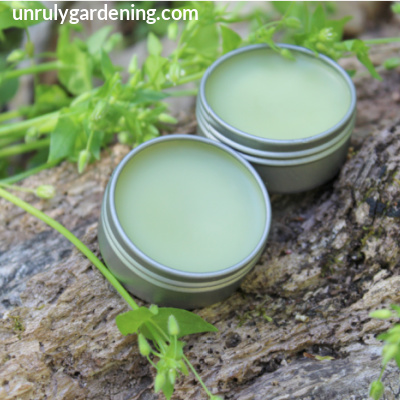
Spring Greens Lip Balm
This recipe can be found right here on our website. It’s a super nourishing lip balm made with early spring greens, including chickweed!

Chickweed Infused Oil & Salve
This chickweed salve is so nice for soothing and healing dry, irritated, or itchy spots and minor wounds or irritations that are caused by bug bites, eczema, or minor scrapes/scratches. It’s gentle enough to use on all ages – even as a diaper rash ointment. Before you can make a salve, you must first make an infused oil.
To make chickweed infused oil:
Infused oils are used as a beneficial ingredient when you make homemade herbal products for your skin, such as salves, ointments, lotion bars, creams, and lip balm. You could even rub an infused oil directly on your skin (like a massage oil), but they aren’t taken internally.
Fresh chickweed has a high moisture content, which could make your oil spoil more easily. For this reason, we recommend using freshly dried herb that’s still a nice green color when infusing your oil.
Making chickweed infused oil is simple:
- Just place about 1/3 cup freshly dried chickweed in a glass canning jar and cover with about twice as much (2/3 cup) oil.
- Cover with a lid and infuse for 4 to 6 weeks, shaking occasionally.
- For a faster infusion, place the capped jar in a sunny window for 2 to 3 weeks, or an even faster method is to set the uncovered jar in a small saucepan of water and heat over a low burner for several hours.
- Once infused, strain your oil and store in a cool dark place.
- Shelf life of the strained oil is about 1 year.
What type of oil to use? Many people like to use olive oil, since that’s easily found in your pantry or local stores. Sunflower oil is another good choice, especially for people with sensitive skin. For a lighter feeling, choose a quick absorbing oil such as jojoba, rice bran, grapeseed, or apricot kernel oil.

To make chickweed salve:
- You’ll need 1.6 oz of chickweed oil + 0.25 ounce beeswax.
- Place the infused oil and beeswax in a heatproof jar, or an empty, cleaned tin can for easy cleanup.
- Set the jar/can down into a small pot containing several inches of water, forming a makeshift double boiler.
- Heat the pan over medium to medium low heat until the ingredients melt together.
- Pour the melted mixture into tins.
- Fills about 1 two-ounce tin. (This recipe can be doubled or tripled.)
- This makes a soft salve that has a shelf life of at least 9 months to 1 year.
- Usage: Rub a thin layer on your skin for itchy skin conditions, minor cuts, and scrapes. It can also be used as a natural salve for diaper rash, or as an anti-inflammatory treatment for sore stiff joints and arthritis.
References & Further Reading
Cech, Richo. Making Plant Medicine. Williams, OR: Horizon Herbs, 2000. Print.
Chandra, Satish and D.S. Rewat. Medicinal plants of the family Caryophyllaceae: a review of ethno-medicinal uses and pharmacological properties. Integrative Medicine Research. 2015 Sep; 4(3): 123–131. Published online 2015 Jul 4. doi: 10.1016/j.imr.2015.06.004
Ma, Lihua, et al. Anti-Hepatitis B Virus Activity of Chickweed [Stellaria media (L.) Vill.] Extracts in HepG2.2.15 Cells. Molecules Journal. 2012 Jul; 17(7): 8633–8646. Published online 2012 Jul 18. doi: 10.3390/molecules17078633
Tilford, Gregory L. and Mary L. Wulff. Herbs for Pets. Mount Joy, PA: Fox Chapel Publishing, 2009. Print.
Our articles are for information and idea-sharing only. While we aim for 100% accuracy, it is solely up to the reader to provide proper identification. Be sure to seek out local foraging classes and plant walks, and invest in mushroom and foraging guides suitable for the area you live in, since some wild foods are poisonous, or may have adverse effect.


